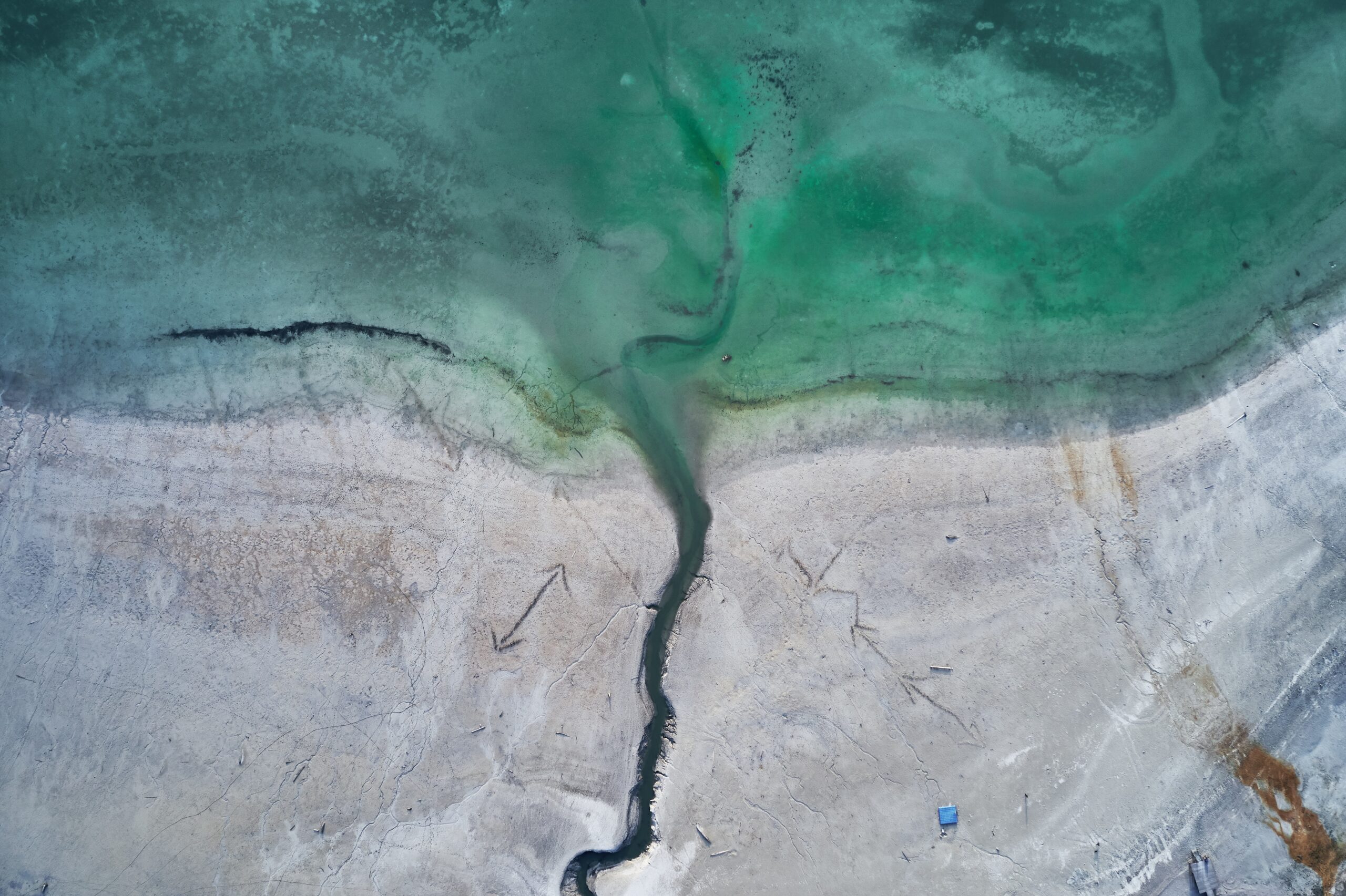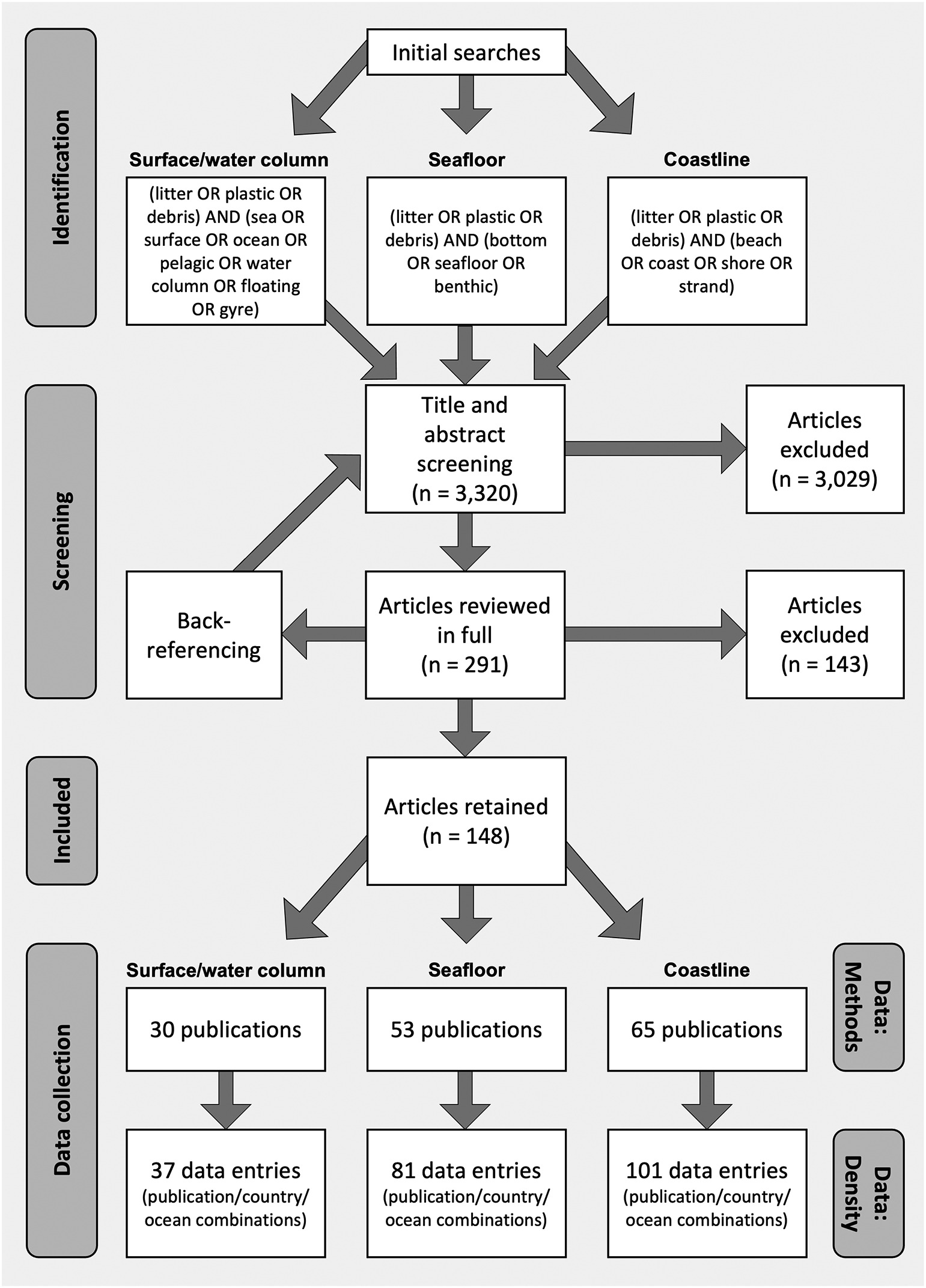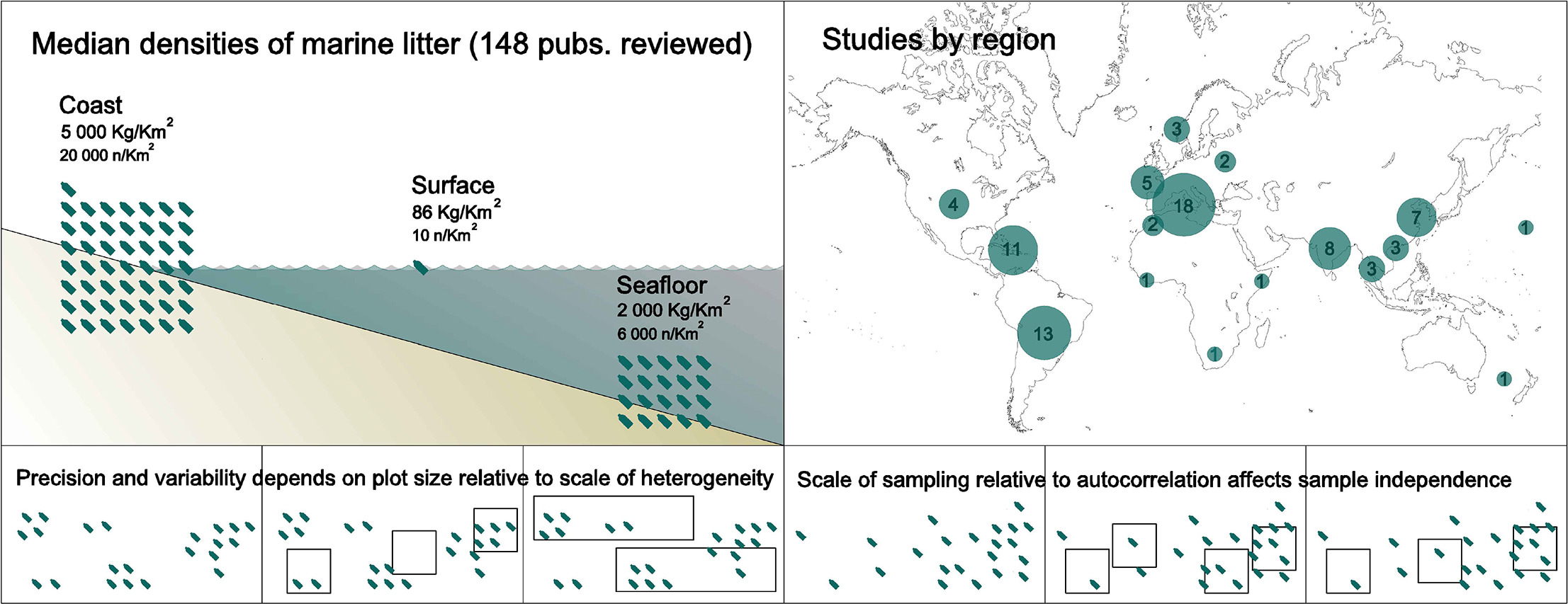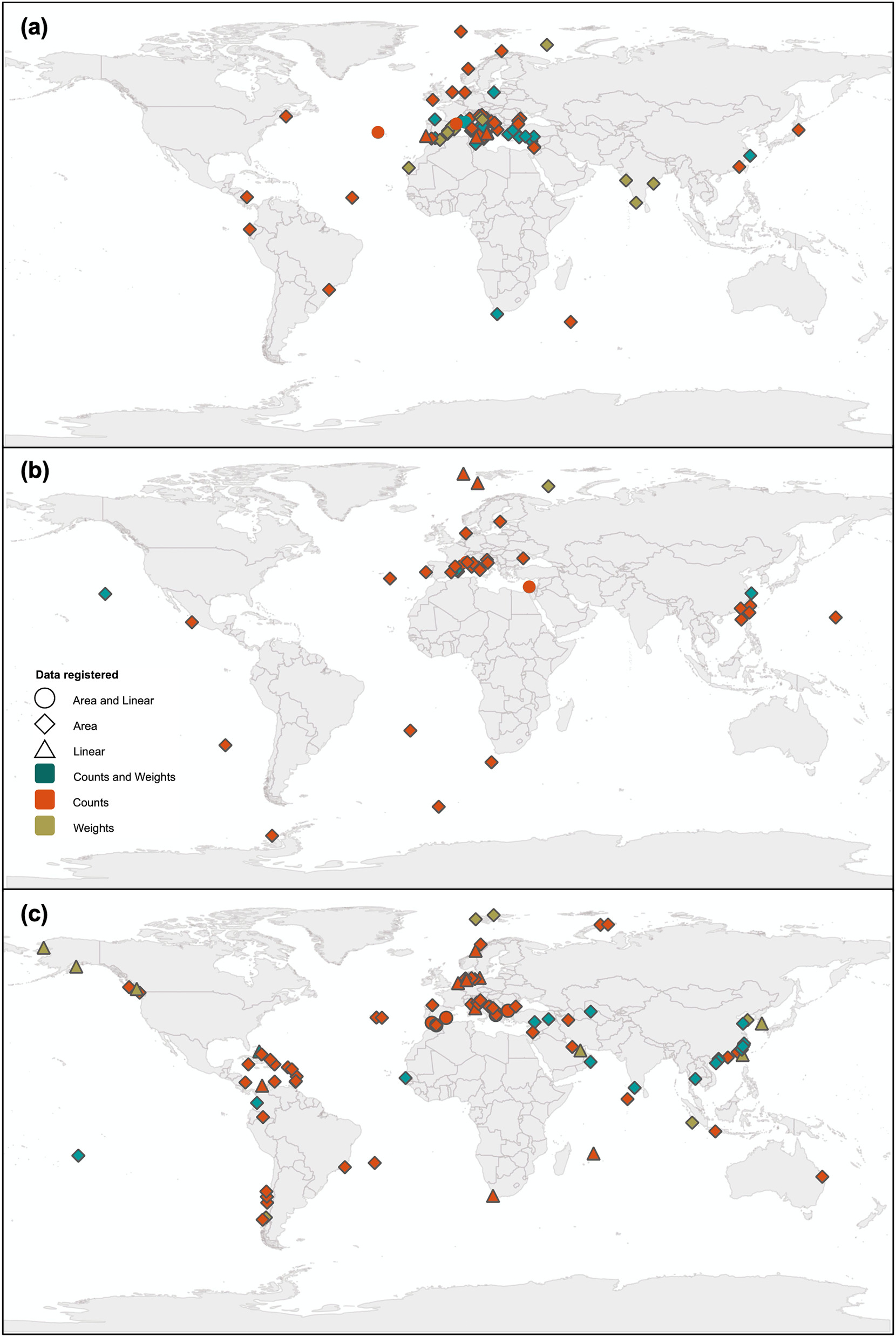Global marine litter research 2015-2020: Geographical and methodological trends

Image by wirestock on Freepik
A systematic review of research on marine macrolitter densities between 2015–2020 revealed considerable knowledge gaps in the field. The review illustrates a great need for survey design development within the field of macro-plastics.
Authors
Marthe Larsen Haarr, senior researcher at SALT
Joan Fabres, Department Head at SALT
Jannike Falk-Andersson, senior researcher at NIVA (previously SALT)
Highlights
- Improved knowledge of the global distribution of litter is important for management.
- A meta-analysis of macrolitter density data published 2015–2020 shows that beach surveys dominate; seafloor and pelagic studies from high seas are lacking.
- Litter density is highest on the coast, data from low-income countries are lacking.
- Survey design (method, plot size/shape, replication) influences density estimates.
RESEARCH BRIEF
Several studies have approached the analysis of macrolitter densities. This paper does a systematic review of the period between 2015 and 2020 to identify the most prevalent issues in the methodologies used and suggest improvements.
One of the key knowledge gaps identified relates to trends in litter densities in time and space across the different marine compartments globally. A trend of data scarcity can be observed in developing countries in particular, which are also estimated to have a higher incidence of waste mismanagement.
Furthermore, there is a persistent lack of data from open seas and pelagic litter even for regions where general data are available.
Need for standardization of monitoring
Marine litter, especially plastics, are part of the global environmental awareness due to the enormous amount of plastic entering the oceans every year.
However, there is a mismatch between the observed abundance of plastics and the estimated inflow. To address this issue, there is a need for standardization of monitoring protocols to create effective regulatory frameworks, as well as implementation of strategies to mitigate the issue. Acquisition of data with high quality also allows researchers to understand the dynamics of the systems where litter is more likely to be transported or deposited.
This study aims to create a synthesis of the existing research on marine macro litter density globally in the different oceanic compartments, to assess the geographic distribution of efforts, global trends and relative litter densities, and to evaluate different sampling methods and their influence on said density estimates.
Methodology
The first step was a systematic literature review. The articles were evaluated based on title, keywords and abstract, and articles required quantitative data on litter density to be included.

From these references data related to litter were extracted to the highest resolution possible, both in terms of spatiotemporal data series and coordinates of sampling sites. The pelagic litter survey methodologies were classified into three categories: visual observations, remote sensing, or trawl.
The seafloor litter surveys were classified into scuba diving, remote sensing, and trawl categories. In the case of beach litter surveys, the classification was divided into census, where the whole survey location was considered, and sub-sampling, where the survey location was divided into transects or quadrats. In all the situations, data on plot size and replication methods were recorded where available. To conduct the statistical analysis of the relevant information, the data were summarized at two different levels: studies and data entries.
The global distribution of macro litter research done in the period between 2015 and 2020 was compared to projected plastic waste emissions generated by other researchers. This analysis was restricted to beach litter surveys alone as it is the most comprehensive dataset.
Figure: Flow chart outlining the systematic review process.
Results
From the 148 research articles analyzed, 44% of the marine macro litter density data were from beach litter studies. The least represented compartment was floating litter with only 20%.
Regarding geographical divisions, several expansive studies included data from multiple countries and/or ocean basins /marginal seas. From these, the largest representation for sea-floor litter came from the North Atlantic in general (81%) and from the Mediterranean specifically (65%). Studies of pelagic litter were also dominantly in the North Atlantic (61%), followed by the North Pacific with 29% of the entries. Out of the stranded litter studies, 58% of the studies were in the North Atlantic, of which 45% were conducted in the Mediterranean.
In a general sense, reporting was mostly done by item counts, with 72% of the studies only reporting this metric. Only 20% of the studies included weight reporting in addition to item counts. The locations, sampling and reporting methodologies are summarized in Figure 2 where there first map (a) shows the entries for seafloor surveys, (b) the pelagic sediment surveys and (c) the stranded litter. There was a large variation in geographical locations and research efforts, which impedes meaningful comparisons among regions.
Some trends in study design and sample methodologies can still be identified from the collection of reviewed articles. In the seafloor litter compartment, trawl surveys were the dominant sampling methodology (52%), followed by remote sensing (36%) and diver-based surveys (13%). For pelagic litter items, most data were collected through ship-based visual surveys (76%). Trawl surveys were the second most common (18%), followed by remote sensing in 6% of the studies. Finally for beached litter, almost all the studies conducted relied on manual surveys (97%), with only two studies using remote sensing, accounting for 3% of studies.

Figure: Graphical abstract of the article.
The lack of standardized and harmonized methodologies is also a likely source of variation in reported densities, which, combined with trends in the spatial distribution of research efforts, leads to difficulties in the assessment of spatial patterns. Pelagic litter surveys reported the highest densities when the survey method was trawling. In stranded litter surveys no systematic variation was observed across different sampling designs during manual surveys. In seafloor surveys, the reported proportions of transects containing litter varied widely. Trawls hauls were the most likely to be polluted, and video or image-based ROV surveys (remote sensing) most likely to be clean, possibly because of the very narrow field of view in the latter.
Another important aspect of reporting methodologies relates to the level of replication. Firstly, the level of replication was not always adequately described. Secondly, it generally varied among methodologies. For seafloor surveys, trawl surveys generally showed higher replication rates, with diver surveys having the lowest values. Remote sensing studies showed a very significant variability in number of replicates (1-5018). For pelagic surveys there was no evident pattern in replication rates, although there were very large variations in sample sizes across all types of survey. In beach litter studies, the number of sites surveyed ranged between 9 (for studies using horizontal transects) to 128 (for studies where the whole beach was surveyed ), but with no significant variation among methods.
Discussion
Regarding the results of geographic and compartmental biases in the reviewed literature, the authors find a high degree of skewness in the data. Most research has been focused on the North Atlantic and specifically the Mediterranean, with the largest ocean, the Pacific, being severely underrepresented in empirical data. This problem is exacerbated by the fact that the regions producing the largest amounts of mismanaged plastic waste are in Asia, which contributes to the number of debris found in the Pacific.

The skew in research in these areas can be most likely be assigned to lower levels of financing in low-income countries, as well as the publication acceptance bias of high-income countries versus the low-income countries. This underrepresentation is found to be in line with other fields of research, but nonetheless still creates large problems in modelling and predictive studies regarding litter distributions.
In the analysis of spatial patterns and gradients of macro litter distributions, the authors found that due to large geographic variations in the somewhat limited data it was not possible to estimate total litter amounts in the environment. However, comparing the reported densities of items shows that pelagic litter is generally found in much lower densities compared to beaches and the seafloor.
The authors concluded that beach cleanup actions would have a higher impact due to not only removing beached litter, but also decreasing the amount of litter in circulation in other compartments as beach litter is constantly washed ashore and resuspended back to sea. An example of the importance of prioritization and targeting of cleanup actions is a study of South Korean coastlines suggesting that 60% of the litter present can be cleaned by targeting just 10% of the coastline.
Figure: Maps showing studies retained in the review by country and ocean basin (i.e., “entries”) for (a) seafloor, (b) pelagic, and (c) stranded litter.
When analyzing spatial gradients, it is also important to consider the proximity to sources, such as regions with high population densities or shipping lanes, as well as geographical and physical characteristics of the environment and litter items. The topography and geometry of the coast and seafloor when interacting with wind and current conditions heavily influence dispersal, which is further convoluted with variables such as litter density, volume, and geometry. All these factors lead to a concentration of distinct litter types in different compartments, and an inherent difficulty in the identification of spatial gradients that can be consistently generalized for wider areas.
Another important gap identified in the analysis, that can have significant impact in the detection of spatiotemporal patterns, is the variation in methodologies applied in the studies. This problem has previously been identified but without great success in enacting changes. The optimization and selection of sampling methods for patchy distributions has been largely ignored in the marine litter research field yet has a high impact when considering statistical precision and accuracy, as well as logistical constraints associated with the data acquisition. The consideration of these factors is important since spatial heterogeneity impacts the independence of data points and can negatively inflate statistical significance. Identifying and mapping these problems can lead to improvements and suggest best practices for the definition of sampling methodologies.
Another important point identified in this review paper is the size of the plots and their adequacy for the study being performed. The effects of plot shape are especially evident when comparing seafloor remote sensing surveys, which are extremely long and narrow, to other methods. This increases the chance of not detecting a litter patch even when passing through it, depending on the density of litter in the patch.
The shape of the plot also impacts the degree of edge effects on items counts by dictating the relative proportion of items crossing plot edges and varying outcomes regarding whether they are counted or not. This last case is particularly relevant for beach, diver, and remote sensing surveys. The remaining methods are less affected due to less interaction between the operator and the substrate, like in the case of trawl surveys where items are either picked or not without much ambiguity (although edge effects may still occur depending on whether or not items are knocked into or out of the path of the trawl). These effects often create a positive bias and are more highly expressed the higher the ratio between edge length and total area.
Generally speaking, increasing the sampling area will reduce the variance in the results, but may also mask smaller-scale spatial patterns. The ideal approach will depend on project goals. However, high variability demands high replication for adequate statistical power and accuracy regardless.
Conclusions
The authors identify substantial knowledge gaps regarding spatiotemporal trends in litter densities across both the different marine compartments and geographical locations. The regions estimated to be the largest contributors of plastic waste influx into marine environments are also the ones that severely lack data about the problem. Addressing this lack of information is an important step to mitigate the problem by developing more efficient cleaning methodologies as well as policies in the more affected regions.
In addition to the geographical distribution, the knowledge regarding relative distributions among ocean compartments is also lacking. Evidence shows that a significant portion of the litter sinks to the seafloor, however most studies are centered around nearshore areas.
Finally, the authors show that the lack of standardization among methods of data acquisition and reporting is also a major problem in the evaluation of analyzing the spatiotemporal distribution of marine litter. Marine litter monitoring technology is still in an immature stage, and as such, there is little standardization of procedures. The improvement of this aspect would greatly benefit the knowledge base necessary for the development of efficient mitigation strategies as well as policy development around the topic.
The full article is available here.